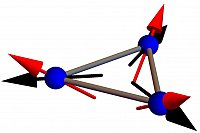Dr. Oliver Busch

Oliver Busch
Over the past few years, my research has focused on the simulation of transport properties in two different regimes: steady-state and ultrafast processes.
In the steady-state regime, I investigated the transverse transport phenomena, particularly the intrinsic anomalous, spin, and orbital Hall effect, on the kagome lattice. Using model calculations based on the tight-binding approach and Berry curvature formalism, I explored the influence of lattice structure, spin-orbit coupling, and noncollinear magnetic textures.
In the ultrafast regime, my work involves simulating laser-induced electron dynamics in thin films with our home-made computational framework EVOLVE: Utilizing an effective one-electron density matrix approach combined with real space tight-binding calculations, allows for examining the time evolution during laser excitation with femtosecond and atomic resolution. My research analyzes the role of surfaces, interfaces, and laser pulse polarization in these processes.
Research topics
Spintronics and Orbitronics:
- Model calculations based on a tight-binding approach
- Time-independent electron transport in Berry-curvature formalism
- Intrinsic anomalous, spin and orbital Hall effect in noncollinear Kagome magnets
Simulation of ultrafast electron dynamics induced by femtosecond laser pulses:
- Real-space tight-binding and one-electron density matrix approach to describe the time evolution according to the von Neumann equation
- Laser excitation in dipole approximation
- Ultrafast transport of spin and orbital magnetic moment in finite systems (heterostructures, monolayers)
Contact
Dr. Oliver Busch
room 0.41a
Von-Seckendorff-Platz 1
06120 Halle (Saale)
phone: +49 (0) 345 55-25443
fax: +49 (0) 345 55-25446
oliver.busch@physik.uni-halle.de
Invited talks
02/2024 - Group seminar Quantum Theory of Materials (PGI, Forschungszentrum Jülich, Germany)
Highlight
Microscopic origin of the anomalous Hall effect in non-collinear Kagome magnets

Non-coplanar virtual magnetic texture
In this theoretical study, we establish the origin of the anomalous Hall effect in non-collinear kagome antiferromagnets on a microscopic level. Despite a vanishing net magnetization, the magnetic point group of certain coplanar systems allows the effect. We go beyond symmetry considerations and analyze the system's Hamiltonian. In doing so, we reveal that spin-orbit interaction and a (virtual) tilting of the magnetic moments out of the kagome plane are equivalent in this model. Consequently, we interpret the anomalous Hall effect in several kagome antiferromagnets as an effective topological Hall effect that originates from a virtually non-coplanar magnetic texture.




